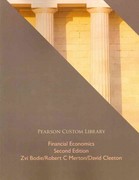Question
Use the following information for problems 3 through 10: The risk-free rate of return is 4%, the required rate of return of the market portfolio
Use the following information for problems 3 through 10: The risk-free rate of return is 4%, the required rate of return of the market portfolio is 10%. You invest $10,000 in stock A, $15,000 in stock B, $50,000 in stock C, and $50,000 in stock D. The average returns and standard deviations of the individual stocks are as follows:
| Ret | Standard Deviation | Beta | |
| Stock A | 0.25 | 0.31 | 2.0 |
| Stock B | 0.16 | 0.36 | 1.0 |
| Stock C | 0.04 | 0.17 | 0.8 |
| Stock D | 0.02 | 0.08 | 0.3 |
1) Assume that you invest another $150,000 in a fifth stock. Stock E has an average rate of return of 0.18, a standard deviation of returns of 0.22, and a beta of 1.8. What is the new portfolios beta?
2)Assume that you invest another $150,000 in a fifth stock. Stock E has an average rate of return of 0.18, a standard deviation of returns of 0.22, and a beta of 1.8. What is the equilibrium expected rate of return of the new portfolio?
3)Assume that you invest another $150,000 in a fifth stock. Stock E has an average rate of return of 0.18, a standard deviation of returns of 0.22, and a beta of 1.8. What is the required rate of return of Stock E?
Step by Step Solution
There are 3 Steps involved in it
Step: 1

Get Instant Access to Expert-Tailored Solutions
See step-by-step solutions with expert insights and AI powered tools for academic success
Step: 2

Step: 3

Ace Your Homework with AI
Get the answers you need in no time with our AI-driven, step-by-step assistance
Get Started


